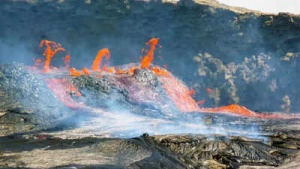Africa's Rift Valley: Mantle Plumes Forge a New Ocean
In the Afar Depression of East Africa, a region where three tectonic plates converge, scientists have uncovered evidence that lava from deep within the Earth's mantle is driving the continent's gradual separation. The research indicates that mantle upwellings are not uniform but rise in complex pulses, triggering volcanic eruptions and seismic activity, and weakening the Earth's crust. This ongoing process is expected to eventually lead to the formation of a new ocean, geographically reshaping the Horn of Africa.
 *Image: Dr Derek Keir, University of Southampton/ University of Florence*
*Image: Dr Derek Keir, University of Southampton/ University of Florence*
Researchers from the University of Southampton and Swansea University analyzed lava samples from over 130 volcanoes in the Afar region. Their analysis revealed that the mantle beneath East Africa exhibits a pulsating behavior, with molten rock rising to the surface in distinct pulses. Each pulse possesses a unique chemical composition, indicating a heterogeneous mantle structure. The movement and thickness of the overlying tectonic plates significantly influence this dynamic activity.
In areas with rapid rifting, such as the Red Sea Rift, the mantle flow is concentrated and intense. Conversely, in regions with slower rifting, the flow is more dispersed. These pulses ascend through weakened areas of the Earth's crust, increasing the likelihood of volcanic eruptions. The chemical variations observed in the lava reflect internal rhythms, offering insights into the link between surface volcanism and subsurface processes.
The plume's activity is also thinning the lithosphere, the Earth's outer layer, to a mere 15 kilometers in certain areas of the Afar Depression. As the plates continue to stretch and thin, they create pathways for more lava to reach the surface, fueling cycles of volcanic eruptions and seismic events. This process mirrors the geological events that led to the formation of the Atlantic Ocean millions of years ago.
The geological activity in the Afar region exemplifies continental rifting, where the African, Arabian, and Somali tectonic plates are diverging. The resulting space is being filled by rising magma and newly formed crust. As rifting progresses, it is anticipated that seawater will eventually flood the region, creating a new ocean basin akin to the Atlantic Ocean that separated Europe and North America.
Ongoing volcanic eruptions are already transforming the landscape. Lava flows from the Erta Ale volcano cover extensive areas of Ethiopia, and frequent earthquake swarms indicate zones of significant tectonic stress. The Boset Volcano displays layers of volcanic deposits, illustrating the long-term impact of mantle upwelling.
These findings provide a window into the birth of an ocean and offer insights into Earth's climate and geological history. Similar mantle plumes in the past have triggered massive volcanic events, such as the North Atlantic Igneous Province, which influenced global climate and potentially contributed to mass extinctions through the release of CO₂ and sulfur dioxide.
Scientists emphasize that collaborative research is essential for understanding these complex processes. Future studies will focus on mapping mantle flows beneath other thinning tectonic plates and predicting how these deep forces shape surface geology. The Afar region serves as a natural laboratory for observing the interaction between Earth's interior and its evolving surface.
Newer articles
 Greg Chappell: Rishabh Pant is Revolutionizing Cricket with Unorthodox Style
Greg Chappell: Rishabh Pant is Revolutionizing Cricket with Unorthodox Style
 Earth's Mantle Unleashes Volcanic Fury, Carving New Ocean in Africa
Earth's Mantle Unleashes Volcanic Fury, Carving New Ocean in Africa
 Najmul Hossain Resigns as Bangladesh Test Captain After Sri Lanka Defeat
Najmul Hossain Resigns as Bangladesh Test Captain After Sri Lanka Defeat
 Smith Targets Test Return After Baseball Cage Rehab in New York
Smith Targets Test Return After Baseball Cage Rehab in New York
 Is Daily Bowel Movement Necessary? When Irregularity Signals a Health Issue
Is Daily Bowel Movement Necessary? When Irregularity Signals a Health Issue
 Shimron Hetmyer's Last-Gasp Six Stuns MI New York, Seals Record MLC Chase for Seattle Orcas
Shimron Hetmyer's Last-Gasp Six Stuns MI New York, Seals Record MLC Chase for Seattle Orcas
 Rishabh Pant's Somersault Celebration Draws "Unnecessary" Remark From Doctor Who Aided Recovery
Rishabh Pant's Somersault Celebration Draws "Unnecessary" Remark From Doctor Who Aided Recovery
 Oral Cancer: Spotting the Signs, Understanding the Risks, and Why Early Detection is Key
Oral Cancer: Spotting the Signs, Understanding the Risks, and Why Early Detection is Key
 India's First Dengue Vaccine Nears Finish Line: Phase 3 Trials Show Promise
India's First Dengue Vaccine Nears Finish Line: Phase 3 Trials Show Promise
 Asia Cup 2025: ACC Reportedly Targets September Start Amid Rising Hopes, Aims for Schedule Release Next Month
Asia Cup 2025: ACC Reportedly Targets September Start Amid Rising Hopes, Aims for Schedule Release Next Month